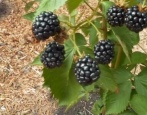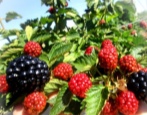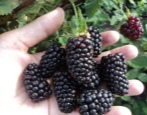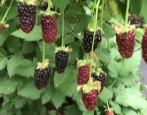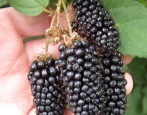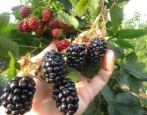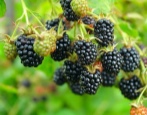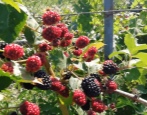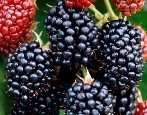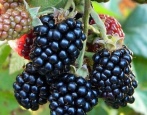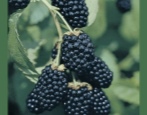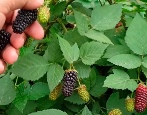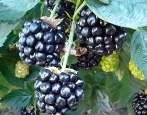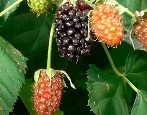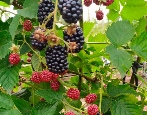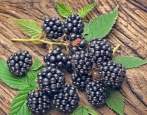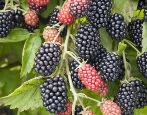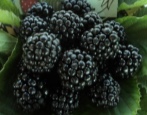
- Authors: Oregon, USA
- Taste: sweet and sour
- Scent : pronounced
- The presence of thorns: Yes
- Berry weight, g: 12-15
- Berry size: large
- Berry color: black
- Fruiting period: from the end of June, extended fruiting - 5-7 weeks
- Frost resistance, ° C / Winter hardiness: winter hardy, –15–18 ° С
- Keeping quality: Yes
Blackberries are a popular berry in modern gardening. It is useful, has a unique taste, it can be used to make not only compote, but also jam. Black Butte is characterized by minimal care, while the variety gives a stable yield, and therefore is in demand throughout the country.
Breeding history of the variety
Little is known about the history of the breeding of the variety. The described variety appeared in the state of Oregon, USA. After some time, Black Butte began to spread throughout the world.
Description of the variety
The bushes are neat. Creeping shoots, have good flexibility. The length of each can reach 3-4 meters. The shrubs grow up to 1.5 m in height. The foliage on the shoots is dark green, gathers in a shamrock. There are thorns on the branches, so you should be careful when picking fruits.
Ripening terms
This is an early variety of blackberries. It begins to bear fruit at the end of June, the collection of berries continues for 5-7 weeks. The variety is grown in various regions of our country.
Yield
The yield of the variety is high. Gardeners collect up to 3.5 kg of berries from each bush.
Berries and their taste
Fruits turn black when fully ripe. They taste sweet and sour, with a pleasant firm pulp, which is moderately juicy. The fruits are quite large, weighing 12-15 grams. Their shape is cylindrical-conical. The aroma of the fruit is pronounced, blackberry.
Growing features
The described variety requires a lot of attention. It is very important to choose the right site. Fertile moist soil is recommended. The correct pH is 5.5-6.5. Before immersing the seedlings in the soil, it is preliminarily loosened and fertilized.
Site selection and soil preparation
This variety does not tolerate high humidity. For disembarkation, a special hole is prepared, inside which there will be high-quality drainage. The dimensions of the pit are 400x400x400 mm.
Before lowering the seedling, a mixture of 5 kilograms of compost or humus, 50 g of potassium salt and one hundred grams of superphosphate is placed in the pit. When planting, root buds are placed 4 centimeters below ground level. It is better at this stage to put a trellis next to each plant. A distance of 1 meter should be kept between the bushes. If the seedlings are planted in rows, then a distance of 2 meters must be maintained between each row. After planting, all the bushes are well watered and then mulched.
Delicious fruits will turn out when grown in the shade, but we must remember that in this case there will be fewer fruit buds. If the landing is carried out in a region with a temperate climate, then it is advised to do it in early spring, before bud break.
Pruning
This procedure is carried out in May. It is held for the second time in the fall. Cut off both the height of the shoots and the lateral growths. This allows for abundant flowering. In an adult bush, it is enough to leave 6 to 8 branches.
Watering and feeding
Blackberries of this variety do not need constant watering, since high humidity is destructive for them. It is worth watering the culture only when there has been no rain for a long time.One-year-old plants are watered once a week. If you do not overmoisten the soil, the berry will turn out to be dense, elastic.
In the first year, the gardener cannot do without fertilizers based on potassium and calcium. Black Butte will respond well to feeding with organic matter or wood ash. In the summer, it is necessary to add potassium sulfate, which is previously stirred in water. In the fall, you can use complex fertilizers, which must contain iron, zinc, boron and other trace elements.
Frost resistance and preparation for winter
Frost resistance Black Butte ranges from -15 to -18 degrees. In this regard, in the middle lane and in the Moscow region, additional shelter is required. The most popular method today is considered to be a special covering material that protects the shoots from frost.
Diseases and pests
In the fight against pests, fungicides, garlic infusion and copper sulfate help. Processing should be carried out twice a year: in spring and autumn.
Reproduction
The breeding methods are as follows:
- root the tops;
- plant green or woody shoots;
- apply the division of the bush.
In nurseries, the culture is propagated by cuttings. Both root and green specimens are used.


